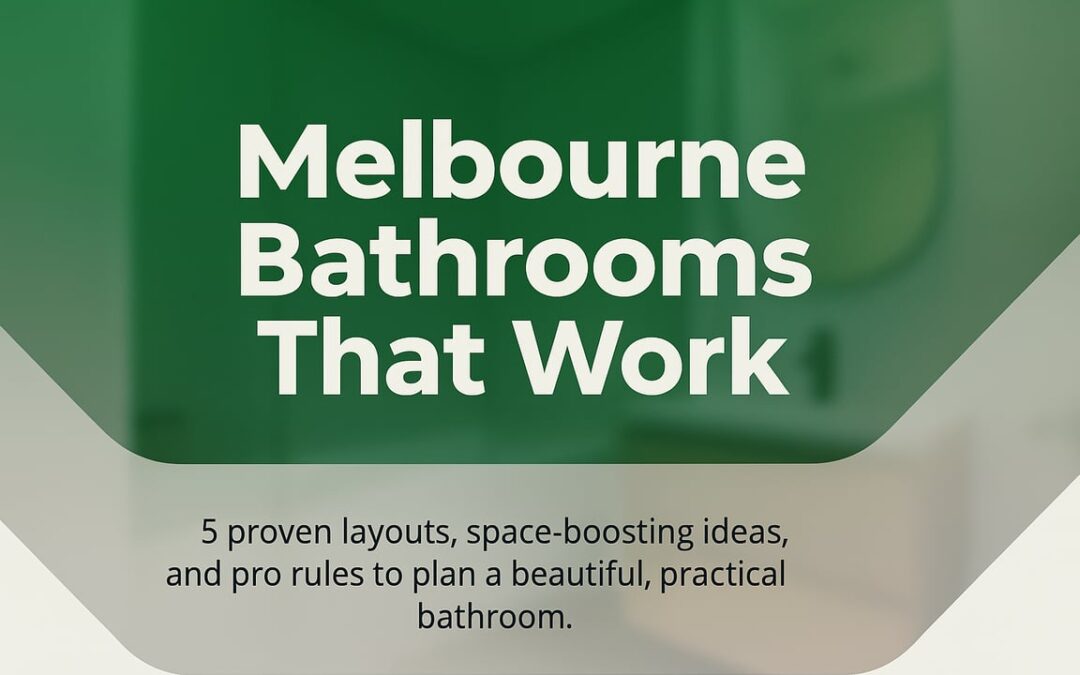Melbourne Bathroom Layouts That Work: Smart Planning For Real Homes
Good bathroom design is less about glossy inspiration and more about getting circulation, storage, and services right for the room you actually have. This practical guide unpacks proven layout principles for Melbourne homes, from compact apartments to expanding family houses, so updates feel great to use every day and add long-term value.
Start With Constraints: Measure, Services, and Structure
- Measure the box – Note wall-to-wall dimensions, ceiling height, window locations, and door swing. A clear footprint reveals what is realistic for fixtures and movement.
- Map existing services – Current plumbing stacks, floor wastes, and electrical points influence cost and feasibility. Relocating a toilet or drain can be done but usually increases spend and timeline.
- Understand structure – Load-bearing walls, slab vs timber subfloor, and ventilation routes determine which reconfigurations are practical without major engineering.
When constraints are acknowledged early, designs become smarter and trade sequencing becomes smoother, which supports on-time and on-budget delivery.
Five High-Function Layout Patterns That Fit Most Rooms
-
Single-Wall Efficiency
All fixtures align along one wall. Ideal for narrow spaces, laundries converted to bathrooms, and compact ensuites. Circulation remains clean, and a walk-in shower at the end creates an uncluttered view line.
-
Galley Balance
Fixtures face each other on two parallel walls. Works in long rooms. Keep at least 900 mm clear aisle and offset basin and toilet to avoid a cramped feel.
-
L-Shaped Corner Comfort
Basin and WC on one wall with the shower or bath wrapping the adjacent wall. Corners are used for storage towers or a wet zone, reducing splash and improving privacy.
-
Three-Wall Luxe
Each fixture gets its own wall. Best for main bathrooms where a separate bath and shower are desired. Zoning allows dual users without conflict.
-
Wet Room Simplicity
Open-plan shower with linear drain, continuous floor tiling, and minimal screens. Excellent for accessibility and easy cleaning. Requires precise falls and certified waterproofing.
Common Melbourne Floor Plans and What Usually Works
- Victorian and Edwardian terraces – Narrow rooms benefit from single-wall or galley layouts. High ceilings suit tall mirrored cabinetry to amplify light.
- Post-war weatherboards – Timber subfloors make plumbing changes more feasible. L-shaped layouts with a concealed WC provide privacy near living areas.
- 70s and 80s brick veneer – Often boxy rooms with small windows. Three-wall layouts can be retained but modernized with a walk-in shower and frameless screen to open sightlines.
- Inner-city apartments – Services are stacked and hard to move. A single-wall plan with a niche-rich shower maximizes storage without feeling crowded.
Space Multipliers: Make Small Bathrooms Feel Larger
- Wall-hung everything – Vanities, toilets, and even tall storage create floor visibility that tricks the eye and simplifies cleaning.
- Frameless glass – Minimal hardware reduces visual interruption and makes the room feel continuous.
- Large-format tiles – Fewer grout lines equal calmer visuals. Run the same tile on floor and walls for a seamless envelope.
- Light layering – Combine task lighting at the mirror, ambient ceiling lights, and a soft night light for safety.
- Mirror strategy – Oversized, wall-to-wall mirrors extend the sense of width. Mirror cabinets add hidden storage.
Clever Storage That Does Not Clog Circulation
- Nib walls and niches – Build a low wall to shield the toilet and add recessed niches in the shower for bottles without protrusions.
- Shaving cabinets – Recessed cabinets keep profiles slim while storing essentials at eye level.
- Tower units – Slim, floor-to-ceiling towers near the vanity hold linens and cleaning products without using much width.
- Vanity drawers over doors – Full-extension drawers organize better and keep the footprint tight.
Waterproofing, Ventilation, and Slips: The Invisible Winners
Beautiful bathrooms age badly without correct wet-area fundamentals. Three essentials support longevity and comfort:
- Certified waterproofing – Membranes must be applied to Australian Standards, with correct upturns, penetrations, and cure times. Corners and niches are frequent failure points.
- Ventilation that matches use – An extractor rated for the room size plus ducting to outside, not into the roof space. Consider a humidity sensor to automate extraction.
- Slip resistance – Look for floor tiles with appropriate slip ratings for wet rooms. Smaller formats or textured finishes improve grip without compromising style.
Fixture Placement Rules That Save Daily Frustration
- Toilet clearance – Aim for at least 750 mm width and 600 mm clear in front. A half-height nib boosts privacy next to the vanity.
- Shower comfort – 900 x 900 mm is a workable minimum; 1000 x 1000 mm feels generous. Place mixers near the entrance so water temperature can be adjusted without stepping in.
- Basin and mirror height – Set the vanity top around 850-900 mm, with mirror lower edges around eye level for the shortest regular user.
- Towel logic – Heated ladders or rails should be reachable from the shower exit. Keep at least 300 mm from wet spray to reduce damp towels.
Lighting That Flatters and Functions
- Task lighting at face height – Sconces or integrated mirror lights reduce shadows for shaving and makeup.
- Ambient ceiling lighting – A central downlight or evenly spaced downlights handle general illumination.
- Accent and night lighting – LED strip under the vanity or a low-level light provides a safe path after dark without glare.
- Color temperature – 3000K to 3500K typically feels warm yet accurate for skin tones.
Budget-Savvy Reconfigurations
Costs are heavily influenced by how far services move, tile coverage, and fixture choice. Three reconfiguration tiers are common:
- Refresh in place – Keep all fixtures where they are and upgrade finishes, storage, and lighting. Good for strata apartments or tight timelines.
- Partial shift – Move a vanity or shower within the same wet zone, keeping the toilet on the existing stack. The room feels new without major plumbing relocation.
- Full rethink – Redesign around new zones, often to create a separate shower and bath, or to improve accessibility. Expect detailed planning and approvals where needed.
Accessibility and Future-Proofing
- Level-entry showers – No steps, with a linear drain and continuous floor. Safer for all ages.
- Reinforced walls – Future grab rails can be added where noggins have been installed now.
- Lever mixers and wide doorways – Easier operation and better mobility.
- Non-slip finishes – Choose textures that balance safety with easy cleaning.
Material Choices That Stand Up To Melbourne Living
- Porcelain tiles – Durable, low porosity, and available in stone-look finishes without the maintenance.
- Engineered stone or porcelain slab tops – Consistent appearance and resilient to splashes.
- Moisture-resistant joinery – Properly sealed edges and ventilation gaps keep vanities looking new longer.
- Quality tapware with solid brass bodies – Reliable cartridges and warranties reduce future issues.
When a Professional Team Makes Sense
Complex bathrooms involve coordinated trades, meticulous waterproofing, and compliance with Australian Standards. A coordinated, end-to-end team can streamline design, approvals, scheduling, and finishing, reducing disruption and rework. For readers planning a full upgrade, explore bathroom renovations Melbourne to see how a managed process can align layout, materials, and craftsmanship for a durable result.
Mini Layout Checklists
- Compact ensuite
- Wall-hung vanity 600-750 mm, mirrored cabinet above.
- Walk-in shower with a single glass panel and corner drain.
- Wall-hung toilet with concealed cistern if space allows.
- Main family bathroom
- Separate bath and 1000 x 1000 mm shower where space permits.
- Double-bowl vanity if two users share mornings.
- Towel storage near exit points and robe hooks outside the shower zone.
- Future-friendly upgrade
- Level-entry shower, slip-rated floor tiles, lever mixers.
- Blocking in walls for optional grab rails later.
- Bright, even lighting with a soft night light.
FAQs
What layout suits a narrow terrace bathroom?
A single-wall or galley layout keeps circulation clear. A frameless, end-of-room shower adds space visually and functionally.
Is a separate bath and shower realistic in a smaller room?
Yes, with careful sizing. A 1500 mm bath and a 900 x 900 mm shower can coexist if storage is vertical and a wall-hung vanity is chosen.
What matters most for longevity?
Correct waterproofing to standards, adequate ventilation ducted outside, and slip-appropriate floor tiles. Details around corners and niches are critical.
How can storage be added without crowding the room?
Use recessed shaving cabinets, in-wall niches, and slim towers. Favor drawers over doors for better organization within a small footprint.

